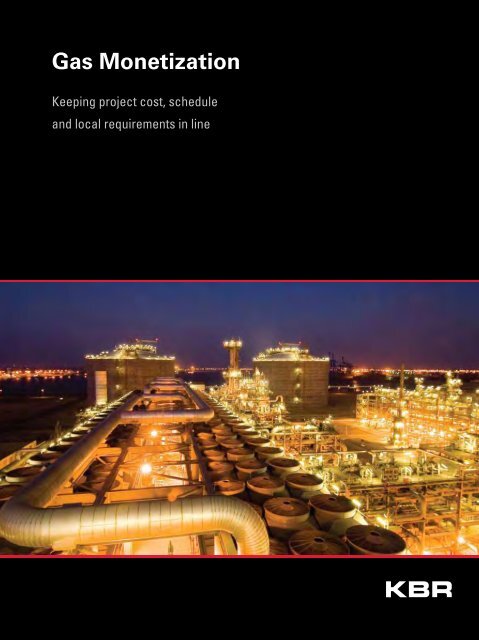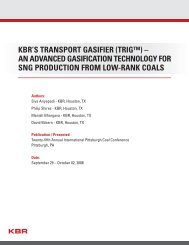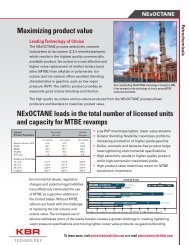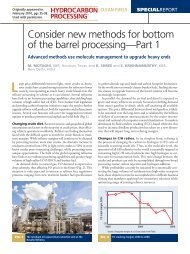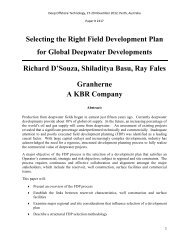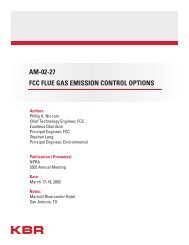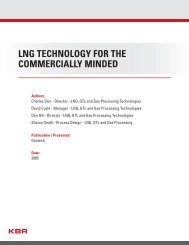Gas Monetization - KBR
Gas Monetization - KBR
Gas Monetization - KBR
You also want an ePaper? Increase the reach of your titles
YUMPU automatically turns print PDFs into web optimized ePapers that Google loves.
<strong>Gas</strong> <strong>Monetization</strong><br />
Keeping project cost, schedule<br />
and local requirements in line
Tangguh LNG turned to <strong>KBR</strong>’s partnership, KJP, to deliver a highly<br />
efficient process, utilizing combined cycle gas turbine compressor<br />
main drivers to minimize CO 2 emissions.<br />
2
Upholding Reputations and Revenues<br />
LNG facilities are complex. Risk can enter the picture at any time, anywhere – from politics and<br />
public relations to procurement and construction. External market factors can cause capital<br />
expenditures and operating costs to escalate without warning. This raises questions:<br />
• Is the timeline realistic and feasible to meet production targets?<br />
• Which issues are likely to impact risk of success?<br />
• How will you economically balance technology, sustainable development and safety?<br />
It’s one thing to identify the issues that affect risk. It’s another to understand and solve them.<br />
With over 30 years of project successes in the LNG industry, <strong>KBR</strong> mitigates risk from project<br />
concept, to design and through every detail of your implementation.<br />
<strong>KBR</strong> has safely and successfully designed and constructed more than half of the world’s<br />
operating liquefied natural gas (LNG) production capacity. And as an experienced EPC company,<br />
we have participated in all but one competitively bid grassroots LNG projects since 1976.<br />
Installing High-Performance Technology<br />
Maybe you have researched the technology you want. But the one thing you avoid locking<br />
into an EPC contractor that only uses proprietary technology. Project bids today require<br />
international companies with global engineering capabilities, systems, procedures and<br />
communications to match the right process technology to your jobsite. While we have a<br />
number of proprietary technologies outside LNG that outperform competitive solutions in<br />
reliability and cost-effectiveness, we are neutral when it comes to LNG technology and are<br />
willing to work with all licensors and equipment suppliers.<br />
Safety reached a record high at Tangguh LNG as the project reached 29 million work hours<br />
without a loss time incident.<br />
Possessing a broad understanding of customer<br />
needs, and providing innovative solutions that<br />
reduce risk in LNG facilities around the world<br />
is a benefit that <strong>KBR</strong> brings to every project.<br />
3<br />
<strong>Gas</strong> <strong>Monetization</strong>
4<br />
Securing Nigeria’s future through technology transfer,<br />
ensuring sustainable development and using Nigeria<br />
resources to the greatest possible extent reflects our<br />
commitment to Bonny Island.
Flexibility and ingenuity is part of every project we take on. In fact, <strong>KBR</strong> was the first to use<br />
the GE Frame 7 as a mechanical driver in an LNG plant at the Malaysia LNG Dua Expansion<br />
Project. This foresight allowed the LNG train design to gain a significant increase in capacity<br />
and take advantage of economies of scale.<br />
Low Cost Proposals Can Be Deceiving<br />
There is usually a reason why a bid is<br />
too good to be true. To put matters into<br />
perspective, the lost production costs of<br />
just one missed project milestone can easily<br />
outweigh the perceived savings promised<br />
by a low-bid contractor. Bids from <strong>KBR</strong> are<br />
competitive, so when you evaluate our<br />
quality personnel, expertise, training and<br />
exceptionally high safety record, there is<br />
Managing Execution Risks<br />
With fast-tracked timetables, environmental<br />
compliance and tight capital budgets,<br />
effective project management and controls<br />
will take you seamlessly from an initial idea<br />
to first LNG. Averting risk during concept,<br />
feasibility, front-end engineering and design<br />
(FEED), detailed design, construction and<br />
commissioning is an area we are well<br />
equipped for after having led our JV partners<br />
in the FEED and EPC of the first 5 million tpy<br />
train in the world at the SEGAS (Spanish<br />
really no comparison. For example, our<br />
project team on Tangguh LNG turned 1,500<br />
cost-saving ideas into 165 optimization<br />
points equaling 100 million dollars in cost<br />
savings over the life of the project. While<br />
some contractors may offer to build your<br />
project for less, we have built a reputation on<br />
delivering on time at reliable cost.<br />
Egyptian <strong>Gas</strong>) facility in Damietta, Egypt.<br />
This plant has one of the shortest project<br />
development schedules: 18 months from<br />
Concept to EPC award, achieving RFSU in<br />
only 35 ½ months for a grassroots LNG<br />
facility—amounting to two years less than<br />
the previous benchmark. Depending on the<br />
magnitude of your project, we can execute<br />
alone or in a joint venture. In fact, our 30 plus<br />
year joint venture alliance with JGC remains<br />
the strongest in the business.<br />
Tangguh LNG is a hyperefficient<br />
facility in that 20<br />
percent of the total energy<br />
demand is supplied from<br />
waste heat recovery.<br />
5<br />
<strong>Gas</strong> <strong>Monetization</strong>
6<br />
Rapid execution and no disruption to operations results<br />
from our comprehensive in-plant work knowledge.<br />
Integrating construction activities with commissioning<br />
activities provides better installation with fewer punch list<br />
items after construction is complete.
Protecting Lives and Environment<br />
LNG facilities are not just about the product; they represent people and the local community.<br />
Creating an incident and injury free organizational climate that practices safe behaviors,<br />
rewards safe performance and minimizes environmental and social impact are differentiators<br />
when choosing an EPC contractor. Achieving project success means safeguarding lives and<br />
improving safety. For example, while working on Nigeria LNG Train 3 in 1999, we reduced the<br />
total recordable incident rate by 70 percent and lost time incident rate by 75 percent compared<br />
to Train 1 and 2 base project in 1995. Train 4 and 5 in the Plus project further improved<br />
recordables by another 30 percent and LTI’s by another 50 percent over the Expansion project.<br />
NLNG 6 lowered the recordables even more by over 50 percent and LTI’s by 33 percent over the<br />
Plus project. Achieving superior safety statistics each year that ranked well below the industry<br />
standard resulted in earning Most Outstanding Multinational Contractor in 2006 and 2007.<br />
PROJECT SCOPE NUMBER OF TRAINS<br />
Base FEED, EPC 2<br />
Expansion FEED, EPC 1<br />
Plus FEED, EPC 2<br />
Six FEED, EPC 1<br />
SevenPlus FEED 2<br />
Each year our commitment to health, safety<br />
and the environment is evident as we<br />
implement our proven and leading standards<br />
and processes, uphold ISO 9001, ISO 14001 and<br />
OHSAS 18001 certifications and continue our<br />
world-class record of training, inoculations and<br />
disease control.<br />
Whether safeguarding the largest remaining mangrove forest in Bintuni Bay, Papua<br />
or implementing comprehensive CO capture solutions for enhanced oil recovery, we<br />
2<br />
continually put lives and the environment first.<br />
Maintaining Cost and Schedule<br />
Risking a massive LNG project with the wrong EPC contractor could cost you your<br />
reputation. The fact is, 99 percent of the criteria affecting your ability to achieve monthly<br />
objectives depends on having the right systems in place and a strong EPC team aligned<br />
with your vision and focused on your goals. <strong>KBR</strong> will assemble the right team to safely meet<br />
production targets and local requirements. That’s the reason Nigeria, Algeria, Malaysia and<br />
Australia have turned to <strong>KBR</strong> repeatedly for LNG plant project execution.<br />
Improving efficiency of operations, conserving<br />
natural resources, safeguarding lives and reducing<br />
emissions is how we operate on a daily basis<br />
The result: we achieved over 140 million<br />
work hours without a lost time incident<br />
across 16 projects in the last six years.<br />
7<br />
<strong>Gas</strong> <strong>Monetization</strong>
8<br />
BP challenged <strong>KBR</strong>’s partnership, KJP, to design<br />
a hyper-efficient facility that would have the least<br />
amount of impact on the remote environment of<br />
Papua, and the team responded.
Maximizing Local Content<br />
Reputable EPC contractors consider<br />
themselves trusting partners interested<br />
in creating job opportunities for the<br />
betterment of your community. Besides<br />
being an industry leader with a spotless<br />
safety record, the contractor you hire needs<br />
experience training workforces of all sizes<br />
and must have an in-depth understanding<br />
of cultural issues to work well with various<br />
governments and communities. Not only do<br />
we train thousands of workers at every LNG<br />
project site, our record of hiring local<br />
employees and contractors is impressive. All<br />
trains at Nigeria LNG were constructed using<br />
90 percent local labor, and we have managed<br />
as many as 18,000 people from 47 countries<br />
on a single worksite during the first phase of<br />
construction on NLNG. Knowing that hiring<br />
locally sustains a country’s economic growth,<br />
it is no surprise that we hired virtually<br />
all local labor for our projects in Egypt,<br />
Malaysia, Indonesia, Australia and Algeria.<br />
Tangguh required a labor force of 8,660 and of that<br />
number, 98 percent were Indonesian<br />
<strong>KBR</strong>’s partnership on Tangguh LNG began with engineering design and<br />
procurement work in Jakarta before relocating the project management<br />
team to the site. The team utilized 450 Indonesian engineers, designers and<br />
specialists in Jakarta to design and execute two LNG trains totaling 7.6 million<br />
tpy that minimized the footprint, facility maintenance and material costs.<br />
Managing Geopolitical Issues<br />
Different countries, different cultures;<br />
and with each comes unique<br />
political challenges. Our expertise<br />
in maneuvering through these<br />
murky waters is unrivaled. Reacting<br />
to changing political and cultural<br />
environments swiftly is a core attribute<br />
we bring to every job.<br />
Identifying and responding rapidly to<br />
situations that might stall production<br />
allows us to continue working and stay<br />
on schedule. Whether it’s overseeing<br />
permits, visas, managing contractors,<br />
gaining security clearances or an array<br />
of other sensitive governmental, land,<br />
environmental or cultural issues, we<br />
manage these jointly to meet your<br />
production goals<br />
Getting Materials and Teams to Jobsites<br />
Navigating the logistics of buying, shipping and controlling a massive amount of equipment,<br />
materials and people help determine the success of your LNG project. Obtaining information<br />
and approvals from government authorities for handling project materials can be an involved<br />
process. Every country has its own set of regulations for importing materials and equipment,<br />
overseeing port congestion and taking safety precautions. Getting project members and<br />
materials through the point of entrance and into the job site safely is an integrated task our<br />
experienced teams perform well.<br />
9<br />
<strong>Gas</strong> <strong>Monetization</strong>
10<br />
Nigeria LNG has achieved an unprecedented rate<br />
of growth through four successive engineering,<br />
procurement, construction and commissioning<br />
projects delivered by <strong>KBR</strong> and its JV partners.
Liquefaction Plants<br />
Major Presence in Nigeria<br />
The Energy Information Administration<br />
ranks Nigeria as the seventh largest natural<br />
gas reserves holder in the world. Our ability<br />
to respond to the increasing global demand<br />
for LNG and our customer requirements is<br />
evident by our ongoing presence in Nigeria<br />
First LNG Plant in Yemen<br />
The decision to launch Yemen’s first LNG<br />
plant was an important one, and <strong>KBR</strong> was<br />
one of three JV partners executing the EPC<br />
scope of a two-train LNG facility for Yemen<br />
LNG Company Ltd. The project consists of<br />
two liquefaction trains with a combined<br />
capacity of 6.7 million tpy, and is expected<br />
to contribute significantly to the economic<br />
growth of the region.<br />
for more than 20 years, resulting in the<br />
design and construction of six LNG trains,<br />
and the FEED of a seventh and eighth. Once<br />
completed, Trains 7 and 8 will be the largest<br />
capacity LNG trains in the world.<br />
Besides playing a critical role in monetizing the country’s natural<br />
gas resources, <strong>KBR</strong> and its JV partners will provide numerous job<br />
opportunities in Yemen during the EPC scope.<br />
Largest LNG Complex in the World<br />
Malaysia LNG chose <strong>KBR</strong>’s JV when needing design, procurement, construction and<br />
commissioning for grassroots or revamp work for eight separate trains over a 20-year<br />
period. Our JV completed the original three trains, MLNG Satu, in 1983; a three-train<br />
expansion, MLNG Dua, in 1995; and a two-train expansion, MLNG Tiga, in 2004.<br />
Malaysia LNG site ranks as the world’s largest single<br />
complex with a total production of 24 million tpy.<br />
11<br />
<strong>Gas</strong> <strong>Monetization</strong>
12<br />
SEGAS’s landmark 5.0 million tpy LNG train set new<br />
standards across the industry. The majority of the gas<br />
exported from SEGAS supplies new ‘cleaner’ gas-fired<br />
power stations in Spain.
Record Firsts in Design, Size and Schedule: SEGAS<br />
SEGAS is the largest train in operation and first operating LNG facility in Egypt, which became<br />
the thirteenth nation to export LNG. Not only did <strong>KBR</strong> and its JV raise the industry standard<br />
by achieving RFSU in only 35 ½ months, we set yet another industry benchmark LNG plant<br />
capacity. The project is a differentiator for <strong>KBR</strong> in that the project team built it to industry<br />
standard not client specifications, and it was a single train versus a two train base project.<br />
Completing a benchmark project like SEGAS in less than 3 years from EPC award to RFSU is a<br />
testament to the innovative spirit, talent and dedication <strong>KBR</strong> brings to every project.<br />
The benchmark performance at the SEGAS facility continues<br />
to reaffirm <strong>KBR</strong>’s position as the industry leader in LNG. Egypt<br />
expects the facility to generate substantial export earnings for<br />
the country.<br />
The SEGAS LNG complex in Damietta came on-stream in the fourthquarter<br />
of 2004 and is exporting LNG to the Spanish market.<br />
Significant experience in developing dynamic simulations, both for process<br />
design and operator training and focusing on advanced engineering<br />
tools helps differentiate <strong>KBR</strong> from our competitors.<br />
13<br />
<strong>Gas</strong> <strong>Monetization</strong>
14<br />
“There was nothing on site when we<br />
first showed up. We arrived on a Zodiac,<br />
walked up the mud flats and entered a<br />
jungle and then had the daunting task of<br />
planning how to move five million cubic<br />
meters of soil, 100,000 cubic meters of<br />
concrete and 1,400 kilometers of cable<br />
as well as house and feed a 9,000 person<br />
workforce…that’s not something just<br />
anyone can do.”<br />
John Baguley<br />
<strong>KBR</strong> Project Manager,<br />
BP Tangguh LNG Project
Smart Optimizations in Tangguh<br />
This project required innovative ways to<br />
save Tangguh LNG money so <strong>KBR</strong> optimized<br />
the project to reduce overall costs,<br />
maximize and guarantee local content,<br />
reduce environmental impact and mitigate<br />
overall project risk. The project team met<br />
all of these objectives including overall<br />
health, safety, security, constructability<br />
and operability targets. Tangguh LNG is the<br />
largest capital development project<br />
underway in Indonesia, and we are involved<br />
in the EPCC joint operation, which includes<br />
construction of a two-train LNG processing<br />
plant each at 3.8 million tpy of LNG with<br />
associated support facilities. Besides saving<br />
more than 100 million dollars over the life<br />
of the project, Tangguh LNG has one of the<br />
lowest rates of CO emissions of recent<br />
2<br />
grassroots projects.<br />
Reliable, cost effective designs are the norm at<br />
<strong>KBR</strong>. Our innovative plot plan in Tangguh saved BP<br />
30 percent in bulk materials<br />
The work scope of this two-train LNG processing plant in Tangguh included development of extensive infrastructure including marine<br />
facilities, product storage, utility support systems and housing and administrative facilities for the plant staff.<br />
15<br />
<strong>Gas</strong> <strong>Monetization</strong>
16<br />
The EPC award demonstrates <strong>KBR</strong>’s ability to solely<br />
execute major, grass-roots LNG projects and its<br />
commitment to achieve Sonatrach’s and Algeria’s<br />
goals for increased LNG production.
Sonatrach Skikda LNG in Algeria<br />
When Sonatrach, Algeria’s national oil and gas company, needed a new LNG train at Skikda<br />
they turned to <strong>KBR</strong>. We signed the EPC contract on July 7, 2007 for Skikda’s 4.5 million<br />
tpy LNG train along with the associated LPG and condensate recovery facilities, and are<br />
handling the pre-commissioning and commissioning part of the contract. This project needed<br />
a flexible and innovative contracting approach in a market where escalating costs and lack<br />
of resources were creating delays. Understanding the changing market, our team came up<br />
with an economical solution that prevailed. On completion, Sonatrach will add a world-class<br />
facility to their portfolio.<br />
More than anything else, our repeat LNG business<br />
– six trains in Nigeria, eight trains in Malaysia and<br />
four trains in Australia – show that customers rely<br />
on <strong>KBR</strong> for liquefaction expertise<br />
Four LNG trains for Woodside Energy, Ltd.<br />
Woodside Energy Ltd. turned to <strong>KBR</strong>’s JV<br />
when they needed a two grassroots LNG<br />
trains followed by two separate LNG train<br />
and another two-train LNG expansion<br />
projects, totaling resulting in 4 liquefaction<br />
trains with a total capacity of 10.7 million tpy.<br />
The services provided include engineering,<br />
procurement and construction management<br />
services for one of Australia’s most important<br />
resource development projects - an LNG<br />
production facility on the Burrup Peninsula,<br />
Western Australia. <strong>KBR</strong>’s JV created about<br />
9,000 direct and indirect jobs across Australia<br />
during the peak construction period, and its<br />
Perth headquarters became home to a staff of<br />
400 as part of the engineering design team.<br />
Trains 1 & 2 of Woodside’s North West Shelf<br />
LNG’s production facility hailed as the world’s<br />
first fully air-cooled liquefaction plant.<br />
17<br />
<strong>Gas</strong> <strong>Monetization</strong>
18<br />
Energy companies rely on our expertise delivering nearly 50 LNG terminals<br />
when selecting an EPC contractor for their grassroots, expansion or<br />
conversion LNG terminal. Extensive experience with feasibility studies,<br />
basic design engineering, FEED and EPC onreceiving terminals and storage<br />
tanks sets <strong>KBR</strong> apart from our competitors.
LNG Receiving Terminals<br />
Delivering the Optimum Solution<br />
LNG producers have relied on our expertise with receiving terminals for more than 30 years.<br />
They count on our vast experience to develop fresh concepts for grassroots regasification<br />
facilities, both onshore and offshore, and for expansions, including technical innovation<br />
and design, cost, permitting, legislation, project execution and consulting services. Other<br />
services we deliver include systems such as jetty and marine facilities, cryogenic piping and<br />
insulation, LNG interchangeability, vaporization systems, and storage and loading facilities.<br />
Constructability in Every Design<br />
Matching your receiving terminal needs with our LNG experience allows us to tailor<br />
solutions to a broad spectrum of project sizes and concepts. This synergy results in optimal<br />
schedules and cost effective designs. To date, we have executed over 45 LNG terminal<br />
projects in our Houston office and MWKL office in London.<br />
Designing over half of the grassroots LNG receiving<br />
terminals in operation outside of Japan – more than<br />
any other contractor – provides communities with<br />
greater access to needed energy resources<br />
Trunkline LNG Company in Lake Charles turned to <strong>KBR</strong> when they<br />
needed design and EPC for their terminal constructed 25 miles inland<br />
from the Gulf of Mexico on an industrial canal.<br />
19<br />
<strong>Gas</strong> <strong>Monetization</strong>
20<br />
With <strong>KBR</strong>’s involvement in the Enagás terminal designs in Huelva<br />
and Cartagena, these projects stand out as the lowest cost terminals<br />
in the world.
LNG Receiving Terminals<br />
Grassroots and Expansion Projects<br />
Enagás – Spain<br />
When Spain’s Enagás needed design<br />
services for two of the lowest cost LNG<br />
terminals in the world, they turned to us.<br />
In just 36 months, we provided the basic<br />
design package and project execution<br />
advisory services during the grassroots<br />
and subsequent expansion phases for two<br />
terminals located in Huelva and Cartagena,<br />
Spain. Both terminals receive, regasify<br />
and distribute Algerian LNG to nearby<br />
communities in Spain and provide feed gas<br />
to a neighboring ammonia plant.<br />
Kogas – Inchon, South Korea<br />
Kogas enlisted <strong>KBR</strong> to provide FEED, EPC<br />
and advisory services for their grassroots<br />
LNG receiving terminal that included<br />
storage, and a jetty and unloading system.<br />
The site now delivers over 14 million tpy to<br />
the Seoul metropolitan area.<br />
DEPA – Revithoussa Island Greece<br />
DEPA turned to <strong>KBR</strong> for FEED and EPC<br />
advisory services and various study reports<br />
for their grassroots LNG receiving terminal.<br />
The project included storage and a jetty and<br />
unloading system, with the ability to handle<br />
LNG vessels with capacities from 25,000<br />
cubic meters to 135,000 cubic meters. Peak<br />
send out rate is 750,000 cubic meters of<br />
natural gas per hour.<br />
Distrigaz S.A. – Zeebrugge, Belgium<br />
Distrigaz awarded <strong>KBR</strong> the FEED and EPC<br />
for their grassroots LNG receiving terminal<br />
located on reclaimed land. The site delivers<br />
670,000 cubic meters of send out per hour,<br />
with 260,000 cubic meters of storage.<br />
Conversion Project<br />
Lattice – Isle of Grain, Kent UK<br />
Lattice turned to <strong>KBR</strong> for pre-engineering<br />
and conceptual design conversion of their<br />
peak shaving plant, now the main source<br />
of LNG import for the United Kingdom. This<br />
site has a capacity of 3.3 million tpy of LNG.<br />
Kogas – Tongyong, South Korea<br />
Kogas awarded <strong>KBR</strong> the FEED and EPC<br />
advisory services for their grassroots LNG<br />
receiving terminal, with a peak sendout<br />
capacity of 990 tons per hour.<br />
Sempra LNG – Cameron, Louisiana<br />
Sempra LNG enlisted <strong>KBR</strong> to build a base<br />
LNG terminal followed by an expansion.<br />
Project management activities included<br />
technical reviews and studies through<br />
estimating and schedule studies as well<br />
as field staffing during the construction<br />
phase. Once completed, the LNG terminal<br />
capacity would expand to 2.6 billion cubic<br />
feet per day.<br />
21<br />
<strong>Gas</strong> <strong>Monetization</strong>
<strong>Gas</strong> <strong>Monetization</strong><br />
22<br />
Offshore/Floating LNG<br />
Reducing cost and shortening the supply<br />
chain from well to liquefaction facility is<br />
a common concern. When gas is so far<br />
offshore that the economics of piping<br />
it onshore become prohibitive, then<br />
offshore LNG can be a solution. Floating<br />
LNG is currently in development, and we<br />
have actively participated in over 15 key<br />
studies dealing with floating liquefaction<br />
and regasification designs. These studies<br />
include GURF (<strong>Gas</strong> Utilization Research<br />
Forum), Statoil (Hammerfest LNG Plant) and<br />
Project Azure, the “Full Floating LNG Chain.”<br />
Expertise in offshore LNG makes <strong>KBR</strong> best<br />
positioned to integrate LNG with the design<br />
and construction of FPSOs. Unlike other EPC<br />
companies, we have extensive engineering,<br />
Leading the GTL Market<br />
GTL facilities are now in progress or under<br />
consideration in gas-rich countries such as<br />
Algeria, Australia, Columbia, Nigeria, Qatar and<br />
Russia. The sheer magnitude of GTL projects in<br />
equipment, scale and resources is a first in the<br />
engineering and construction industry. At peak,<br />
these technically challenging projects require a<br />
workforce of 30,000 to 50,000.<br />
Along with our gas alliance partner, JGC, we<br />
have established ourselves as leaders in the GTL<br />
market as we are involved in two of the three<br />
ongoing GTL projects around the world, Escravos<br />
in Escravos, Nigeria and Pearl in Ras Laffan, Qatar.<br />
procurement and construction management<br />
(EPCm) experience in FPSOs spanning<br />
decades including Hibernia, Agbami, Plutonio<br />
and others. In addition, we have been a<br />
member of the Azure consortium, a program<br />
funded by the European Union to advance the<br />
development of floating LNG supply chains.<br />
Reducing risk in offshore LNG concepts is<br />
an area in which <strong>KBR</strong> has a great deal of<br />
expertise. When a JV between operator<br />
Woodside, BP, BHP Billiton, Chevron and<br />
Royal Dutch Shell needed expert help for<br />
their “Browse to Burrup” Development, they<br />
enlisted <strong>KBR</strong> to develop their floating LNG<br />
concept. This project included 20 trillion cubic<br />
feet of gas located offshore Western Australia.<br />
In February of 2007, HRH Prince of Wales visited Pearl GTL to help<br />
lay the foundation stone to mark the beginning of construction.<br />
Located in Qatar, Pearl GTL is one of the largest construction and<br />
engineering projects in the world today.<br />
In Escravos, <strong>KBR</strong> along with our JV are delivering EPC services for Chevron Nigeria Limited.<br />
And in Pearl, <strong>KBR</strong> and JGC are providing project management and cost-reimbursable EPCm<br />
services for Qatar Shell GTL Limited, a company of the Royal Dutch/Shell Group.<br />
Reduce Cost. Maintain Schedule. Minimize Risk. Safeguard Lives.<br />
Mitigating risk on your multi-billion dollar LNG project is a joint effort best led by industry<br />
experts. A proven EPC partner who has amassed more than half of the world’s operating<br />
LNG production capacity since 1976. An EPC company known for LNG innovation, quality<br />
and execution: <strong>KBR</strong>.<br />
To learn more, visit: www.kbr.com/lng or e-mail lng@kbr.com
<strong>Gas</strong> <strong>Monetization</strong>
www.kbr.com<br />
©2008 <strong>KBR</strong>, Inc.<br />
All Rights Reserved<br />
Printed in U.S.A.<br />
K08084 4/08<br />
080100<br />
www.kbr.com


